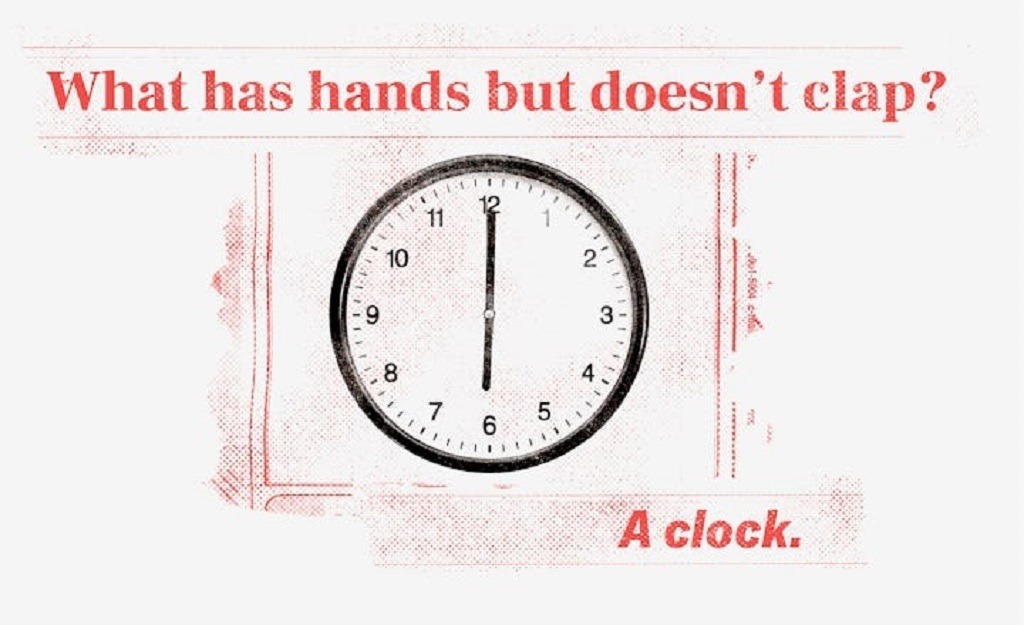Puzzles like this one have a way of sticking in your mind. The question “What has hands but can’t clap?” seems simple at first, but it forces you to think differently. The solution is a clock, an everyday item with hour and minute hands that tell time without any ability to applaud. This riddle plays on double meanings, where “hands” refers not to human appendages but to the pointers on a clock face. It’s a classic example of how words can mislead us, encouraging creative problem-solving. Riddles of this sort date back centuries, often used to sharpen wits in social gatherings or educational settings. They remind us that answers hide in plain sight, wrapped in clever language. If you’ve ever been stumped by such a teaser, you’re not alone—it’s designed to challenge assumptions. Therefore, understanding its mechanics can enhance your appreciation for linguistic tricks. In the following sections, we’ll break it down step by step, exploring why it works and what it teaches.
Many people first hear this puzzle during casual conversations or in joke collections. It stands out because it combines familiarity with surprise. The clock, as the key, represents something mechanical yet essential in daily routines.
For a deeper dive into similar enigmas, explore the analysis on hands but cant clap. Additionally, platforms like BeReviewers provide thoughtful reviews on puzzles and brain teasers, helping enthusiasts discover more.
What Is the Solution to the Riddle “What Has Hands but Can’t Clap”?
The direct answer is a clock. This device features two or three hands—the hour, minute, and sometimes second—that move across its face to indicate time. However, it lacks any capacity to clap, as those hands are inanimate parts of a mechanism.
Let’s expand on this. Clocks have been around since ancient times, evolving from sundials to mechanical versions in the Middle Ages. The term “hands” for clock pointers originated in the 16th century, drawing from the resemblance to human arms pointing directions. This linguistic choice sets up the riddle perfectly. When you hear “hands,” your brain jumps to human or animal limbs capable of actions like clapping. Yet, the puzzle redirects that thinking to an object. It’s a form of misdirection, common in magic and comedy. Therefore, the solution feels satisfying once uncovered—it resolves the tension built by the question.
Consider how this applies broadly. In problem-solving, we often overlook obvious elements because of preconceived ideas. A clock sits quietly on walls or wrists, its hands in constant motion but silent. No applause, just steady progress. This riddle underscores that point. Moreover, variations exist, such as “What has a face and two hands but no arms or legs?” which also points to a clock, adding layers to the theme. According to sources like Scout Life, this puzzle appears in children’s joke books, making it accessible yet enduring.
Analyzing further, the riddle’s appeal lies in its brevity. Short questions pack a punch, delivering quick mental exercise. People share them at parties or online, fostering connections through shared “aha” moments. However, not everyone solves it immediately. Some guess gloves or maps, which have “hands” in different contexts—like left and right hand for gloves. Those alternatives show the riddle’s versatility, but the clock fits best due to its active “hands.” In educational contexts, teachers use it to teach metaphors and analogies. Overall, this solution reveals how everyday objects inspire timeless brain teasers.
Why Does This Riddle Confuse So Many People?
It confuses because it exploits ambiguity in language. “Hands” has multiple meanings, leading the mind toward living beings rather than inanimate items.
Diving deeper, human cognition favors literal interpretations first. Psycholinguistics explains this—words trigger immediate associations based on frequency of use. “Hands” most often means body parts, so clapping follows logically as an action. The riddle blocks that path, creating cognitive dissonance. You pause, rethink, and search for alternatives. This process engages the brain’s lateral thinking areas, as studied in cognitive science. For instance, riddles activate the prefrontal cortex, enhancing creativity.
Additionally, cultural factors play a role. In English-speaking societies, clocks are ubiquitous, yet we rarely personify their parts. This oversight amplifies the trick. However, in other languages, the pun might not translate directly, limiting its global reach. Some adaptations use equivalents like “arms” in French clocks. Despite this, the English version persists in popular culture.
People’s experiences influence confusion levels. Children, with less exposure to idioms, might struggle more, while adults draw from broader knowledge. Yet, even experts get stumped occasionally. Transitioning to solutions, once you know it’s a clock, the confusion evaporates. But the initial bafflement is key to its charm. As explored in this Medium piece, it subtly comments on time’s relentless nature—hands that move but never celebrate.
Furthermore, social sharing amplifies confusion. When posed in groups, wrong guesses build, heightening the reveal’s impact. Online forums buzz with debates, showing its enduring puzzle power. In summary, the confusion stems from clever wordplay that hijacks expectations, making the resolution all the more rewarding.
Are There Similar Riddles That Use Wordplay Like This?
Yes, many riddles rely on double meanings. For example, “What has a head and a tail but no body?” answers with a coin.
Expanding, wordplay riddles form a large category in folklore. They twist common phrases to surprise. Another classic: “What can run but never walks, has a mouth but never talks?” That’s a river. Like our clock puzzle, it attributes human traits to non-human things. This anthropomorphism tricks the listener.
Historically, such teasers appear in ancient texts, like the Riddle of the Sphinx from Greek mythology. Though more complex, it shares the essence of challenging perceptions. In modern times, they populate books and apps. Variations of the hands riddle include “What has hands and a face, but can’t hold anything or smile?” Again, a clock.
Why do these persist? They boost vocabulary and critical thinking. Educators incorporate them into lessons for that reason. However, overuse can dull their edge. Still, fresh twists keep them alive. For uniqueness, consider how technology inspires new ones, like “What has keys but can’t open locks?” A keyboard.
Comparing, our riddle stands out for its simplicity. No elaborate setup, just a punchy question. Therefore, it’s ideal for quick entertainment. Collecting similar ones reveals patterns—objects with body-part names often star in them, like necks on bottles or eyes on potatoes. This analytical view shows riddles as linguistic puzzles, decoding everyday speech in novel ways.
How Has This Riddle Evolved Over Time?
It has remained largely unchanged, but adaptations include watches or digital clocks in modern retellings, though the core stays the same.
Tracing back, origins are murky, likely emerging in the era of mechanical clocks around the 17th century. Early joke books from the 1800s might reference similar puns. Over decades, it spread via oral tradition, then print media.
In the digital age, memes and social media propel it further. Variations poke at smartwatches, questioning if digital hands count. However, traditionalists stick to analog clocks for the visual pun.
Culturally, it appears in children’s literature and TV shows, reinforcing its timelessness. Analytical lenses reveal it as a commentary on machinery versus humanity—hands that serve without emotion.
Additionally, global translations adapt it, sometimes losing punch but gaining new flavors. In education, it evolves into teaching tools for language arts. Overall, its evolution mirrors society’s tech shifts, yet the fundamental cleverness endures.
What Psychological Benefits Come from Solving Riddles Like This?
Solving boosts cognitive flexibility, improving problem-solving skills and mental agility.
Delving in, research shows riddles enhance brain plasticity. They force neural pathways to reroute, fostering innovation. For kids, this builds resilience against frustration.
Adults benefit too, warding off cognitive decline. Studies link puzzle-solving to better memory. However, moderation matters—overdoing can cause stress.
Socially, sharing riddles strengthens bonds, sparking discussions. In therapy, they’re used for mindfulness, distracting from worries.
Unique to this riddle, it teaches perspective-shifting. Seeing “hands” differently applies to real-life challenges. Therefore, it’s more than fun—it’s a mental workout with lasting effects.
Can This Riddle Be Used in Educational Settings?
Absolutely, it’s great for teaching language nuances and critical thinking in classrooms.
Teachers pose it to illustrate homonyms and metaphors. Students discuss guesses, learning collaboration.
In STEM, it ties to time concepts, explaining clock mechanics. Art classes might draw interpretations.
However, accessibility varies—visual learners grasp it quickly via diagrams. For uniqueness, pair it with history lessons on inventions.
Outcomes include heightened engagement and vocabulary growth. Thus, it’s a versatile tool across grades.
Why Should You Share This Riddle with Others?
Sharing sparks joy and conversations, turning mundane moments into engaging ones.
In groups, it breaks ice, revealing personalities through guesses. Online, it goes viral, connecting strangers.
Moreover, it promotes humility—everyone stumbles sometimes. Encourage trying it at family dinners for fun.
With its simplicity, it’s inclusive. Therefore, spread it to keep the tradition alive.
Wrapping Up: What Makes This Riddle Timeless?
This puzzle endures because it blends simplicity with surprise, offering quick mental stimulation in a busy world. The clock as answer reminds us of time’s quiet passage, adding philosophical depth. We’ve explored its mechanics, variations, and benefits, showing its value beyond entertainment.
However, its true power lies in sparking curiosity. Next time you glance at a clock, remember the hands that can’t applaud your day. To dive deeper, try creating your own riddles or exploring collections. Visit sites like Scout Life for more inspiration. As a call to action, share this with a friend today—see their reaction and discuss. Puzzles like this enrich life, one clever twist at a time. Keep questioning the ordinary; answers often hide there.
Read More Also: How to Set Up Your Robotic Vacuum
FAQ
What is the classic riddle about hands that can’t clap?
The classic is “What has hands but can’t clap?” It’s a wordplay teaser popular among all ages.
Is the answer to this riddle always a clock?
Primarily yes, but some suggest a watch, which shares the same logic. Both have hands for time-telling without clapping ability.
Are there any other possible answers to this puzzle?
Creative minds propose alternatives like a map (with hand symbols) or a statue, but the clock fits most precisely due to its moving hands.
How can I create my own riddles similar to this one?
Start with everyday objects and their attributes. Assign human actions they can’t do, like “What has eyes but can’t see?” (a potato). Test on friends for refinement.
Why do riddles help with brain development?
They encourage lateral thinking, improving memory and creativity. Regular practice sharpens focus and problem-solving, beneficial for all ages.
What are some books or resources for more riddles?
Look into “Riddles and More Riddles” by Bennett Cerf or online sites like Riddles.com. These offer thousands, categorized by difficulty.
Can this riddle be adapted for different cultures?
Yes, by translating and adjusting for local idioms. In some places, it becomes about other time devices, maintaining the core pun.







